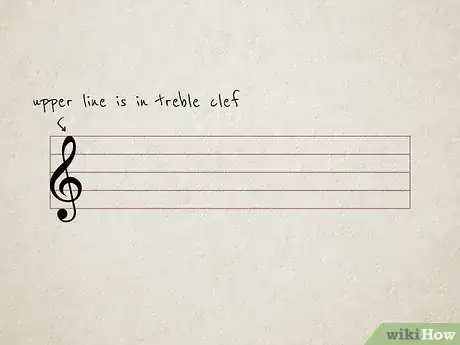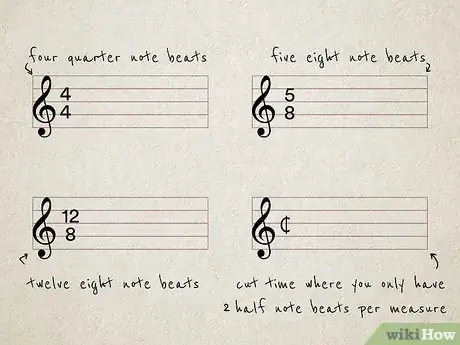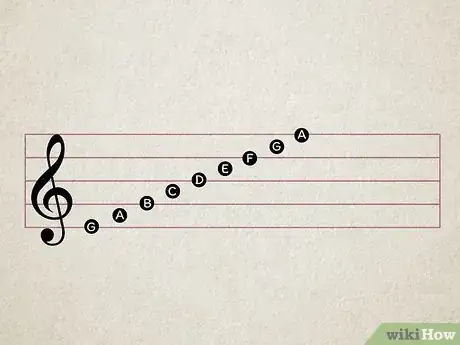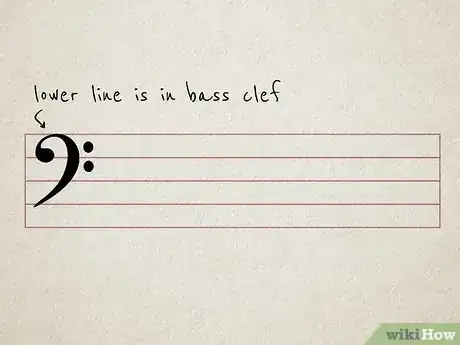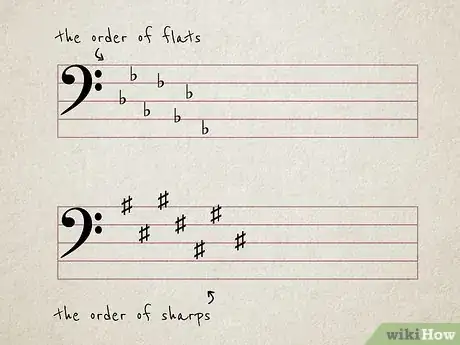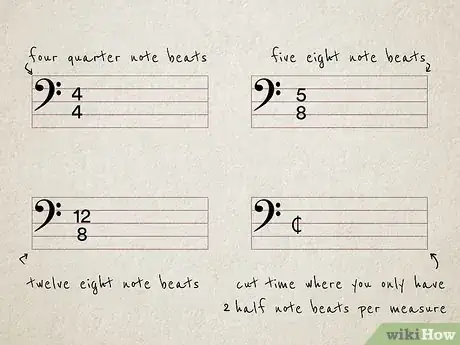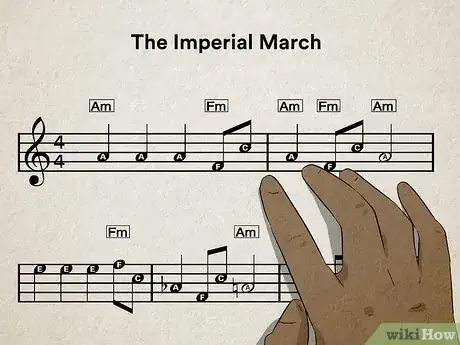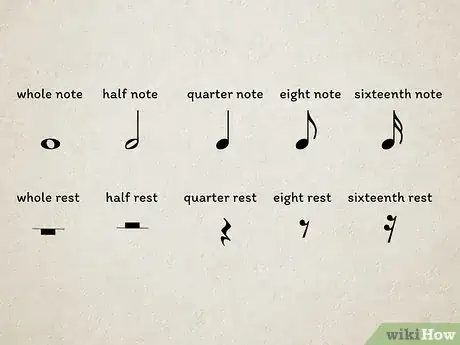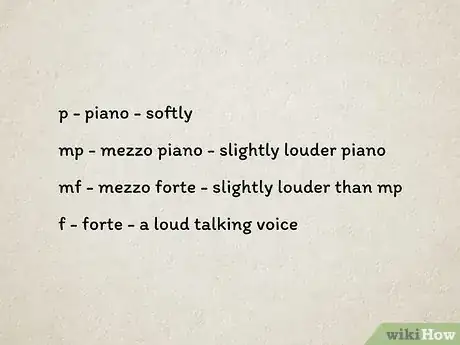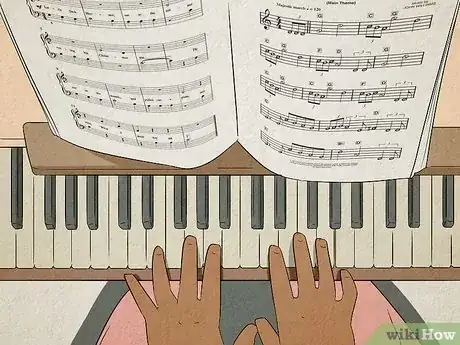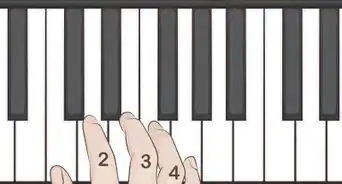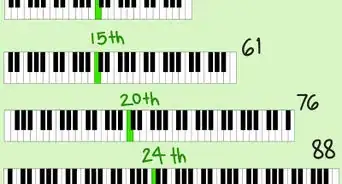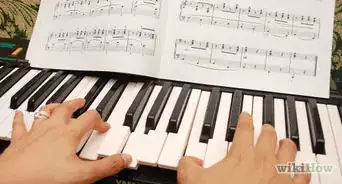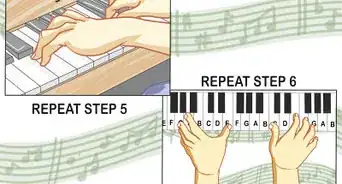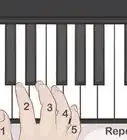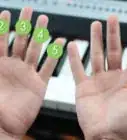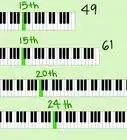This article was co-authored by Michael Noble, PhD. Michael Noble is a professional concert pianist who received his PhD in Piano Performance from the Yale School of Music. He is a previous contemporary music fellow of the Belgian American Educational Foundation and has performed at Carnegie Hall and at other venues across the United States, Europe, and Asia.
This article has been viewed 37,573 times.
Once you can read all the notes, playing piano can be a very fun and relaxing activity. Reading piano music can be hard to figure out, since you're playing two lines of music at once. Before starting, know that the line of music on top is going to be the right hand (treble clef) while the one below it is the left (bass clef).
Steps
Reading the Upper Line
-
1Determine if the upper line is in treble clef. While it's not so common for the bass clef to be in the right hand, it is still a possibility; such as when the music requires your hands to cross for example! If your sheet music has bass clef in the right hand, you can skip this part of the process.
-
2Learn the key signature. The key signature comes right after the treble clef. This will consist of flats and sharps of different notes. There are also orders of flats and sharps to help you determine the key signature quickly and easily. The order of flats is B - E - A - D - G - C - F. The order of sharps is the same as the order of flats, but reversed. The order is then F - C - G - D - A - E - B. For example:
- Remember that a sharp looks like '#' and a flat looks like 'b'
- Notice the key signature has 3 flats. Therefore, B, E, and A will all be flat.
- Notice the key signature has 6 flats. Therefore, B, E, A, D, G, and C will be flat.
- Notice the key signature has 2 sharps. Therefore, F and C will be sharp.
- Notice the key signature has 5 sharps. Therefore, F, C, G, D, and A will be sharp.
Advertisement -
3Learn the time signature. The time signature is the two numbers at the beginning of the line. The top number will indicate how many of the lower-number notes are in each bar. For example:
- 4 / 4 will have FOUR QUARTER note beats
- 5 / 8 will have FIVE EIGHTH note beats
- 12 / 8 will have TWELVE EIGHTH note beats
- A "C" with a line through it means cut time where you only have 2 half note beats per measure
-
4Learn where the notes are. There are 5 lines which indicate these notes in order from bottom to top: E - G - B - D - F. Then, in between those lines, you have F - A - C - E.
- If a note is above the staff (above the five lines) the pattern of notes continues as shown above
Reading the Bass Clef
-
1Determine if the lower line is in treble clef. Again, it is possible to have treble clef in the left hand (lower line). If that is the case, you can refer back to Part 1 to understand the rhythms and time signatures.
-
2Learn the key signature. The key signature shouldn't be different from the treble clef's signature if your right hand is treble clef. To determine what notes are flat and sharp, you can refer to the order of flats and sharps. The order of flats is B - E - A - D - G - C - F. The order of sharps is the same as the order of flats, but reversed. The order is then F - C - G - D - A - E - B. For example:
- Remember that a sharp looks like '#' and a flat looks like 'b'
- Notice the key signature has 3 flats. Therefore, B, E, and A will all be flat.
- Notice the key signature has 6 flats. Therefore, B, E, A, D, G, and C will be flat.
- Notice the key signature has 2 sharps. Therefore, F and C will be sharp.
- Notice the key signature has 5 sharps. Therefore, F, C, G, D, and A will be sharp.
-
3Learn the time signature. Again, this is no different than the treble clef's. The time signature is the two numbers at the beginning of the line. The top number will indicate how many of the lower-number notes are in each bar. For example:
- 4 / 4 will have FOUR QUARTER note beats
- 5 / 8 will have FIVE EIGHTH note beats
- 12 / 8 will have TWELVE EIGHTH note beats
- A "C" with a line through it means cut time where you only have 2 half note beats per measure
-
4Learn where the notes are. For bass clef, there are still 5 lines, but different notes to go with them. Starting from the bottom line to the top, G - B - D - F - A. The lines in between will be A - C - E - G.
- If a note is above the staff (above the five lines) the pattern of notes continues as shown above
Putting It All Together
-
1Learn each note at a time. Now you can continue to start reading sheet music. It is essential to learn the difference between a single note and a chord. A chord will be multiple notes stacked on top of each other. This simply means that you must play all of those notes at once to play the chord.
-
2Learn the rhythm. There are a lot of different types of notes that correlate to different rhythms.
-
3Learn the dynamics. Dynamics are letters that generally appear between the lines of the right and left hand.
- p - piano - softly
- mp - mezzo piano - slightly louder piano
- mf - mezzo forte - slightly louder than mp
- f - forte - a loud talking voice
-
4Learn the articulation. There are lots of different kinds of articulation that signify a lot of things.
- 1 - Staccato - played very short and to the point
- 2 - Slurs - played so that the notes don't have any gaps of sound between them
- 3 - Tepee - Played short but with "umph"
- 4 - Accent - Played with force at front
- 5 - Legato - played triumphantly to the notes extent
-
5Play them together. This last step is very tricky if you're just learning piano. A neat tip is that the notes/chords line up from right to left hand. The notes in the picture above shows that.
Expert Q&A
-
QuestionCan you teach yourself to read piano music?
 Michael Noble, PhDMichael Noble is a professional concert pianist who received his PhD in Piano Performance from the Yale School of Music. He is a previous contemporary music fellow of the Belgian American Educational Foundation and has performed at Carnegie Hall and at other venues across the United States, Europe, and Asia.
Michael Noble, PhDMichael Noble is a professional concert pianist who received his PhD in Piano Performance from the Yale School of Music. He is a previous contemporary music fellow of the Belgian American Educational Foundation and has performed at Carnegie Hall and at other venues across the United States, Europe, and Asia.
Professional Pianist You could definitely teach yourself. YouTube and other instructional videos online can be a great resource. If you want to learn basic theory online, start looking at a keyboard, and watch the videos as you're playing.
You could definitely teach yourself. YouTube and other instructional videos online can be a great resource. If you want to learn basic theory online, start looking at a keyboard, and watch the videos as you're playing. -
QuestionHow do I read notes written on ledger lines?
 Buggylu25Top AnswererPretend that the ledger lines are just small extensions of the musical staff. The notes continue in the same order. If you need help identifying the notes, find a familiar note on the staff. From there, count up/down until you reach the note on the ledger line.
Buggylu25Top AnswererPretend that the ledger lines are just small extensions of the musical staff. The notes continue in the same order. If you need help identifying the notes, find a familiar note on the staff. From there, count up/down until you reach the note on the ledger line.
